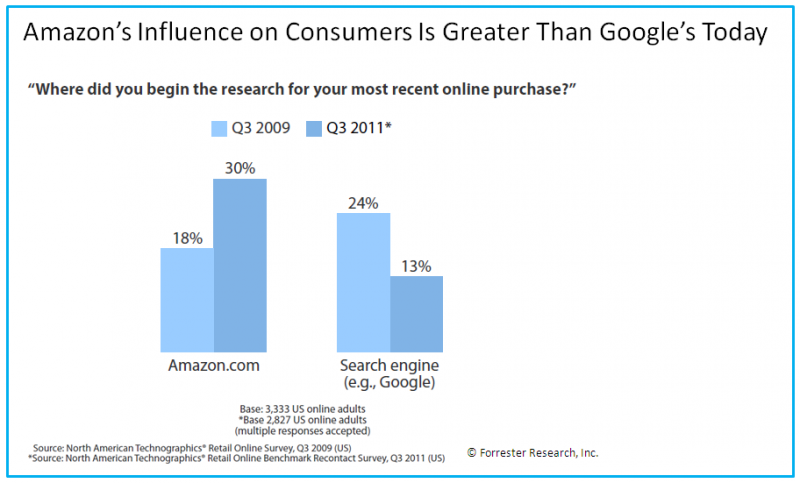Amazon.com: Friend or Foe?
As Amazon.com has grown aggressively in recent years, expanded into diverse businesses, and achieved profitability, its impact on the eBusiness and retail sectors is greater now than ever before. For many businesses, Amazon is simultaneously a sales channel, a potential service provider, and a competitive threat. To explore this complex relationship and to understand Amazon both today and where they are going next, my colleague Sucharita Mulpuru and I conducted many interviews with retail industry leaders, former Amazon leadership, and industry thought leaders – culminating in our latest report.
In the report we look at Amazon’s significant influence on retailing in the US today, the key factors driving Amazon’s amazing growth, what we can expect from Amazon next, and how retailers can effectively compete and coexist with Amazon. We also look at Amazon’s vulnerabilities, including:
 Flopping in key emerging markets. Amazon’s international strategy has been successful in key European markets, especially Canada, Germany, and the UK. But the firm has found less success in other markets — China in particular. Amazon’s market share in China pales in comparison with Taobao, which commands more than 75% of the Chinese online retail market. Amazon’s share of the Chinese market is estimated at just 2.2%, far below either Taobao or 360Buy. Amazon may also struggle in the other BRIC nations — Brazil, India, and Russia — particularly when faced with local pure-play and multichannel incumbents with established footholds in those markets.
Flopping in key emerging markets. Amazon’s international strategy has been successful in key European markets, especially Canada, Germany, and the UK. But the firm has found less success in other markets — China in particular. Amazon’s market share in China pales in comparison with Taobao, which commands more than 75% of the Chinese online retail market. Amazon’s share of the Chinese market is estimated at just 2.2%, far below either Taobao or 360Buy. Amazon may also struggle in the other BRIC nations — Brazil, India, and Russia — particularly when faced with local pure-play and multichannel incumbents with established footholds in those markets.- Facing hostile retailers. Much of Amazon’s success rests on the growth of its third-party marketplace and services such as Fulfillment by Amazon. These programs fundamentally rely on other companies embracing Amazon as a place to do business. However, many brands and retailers have a growing distrust of Amazon, as they sense that they are teaching Amazon too much by selling to or through Amazon. If a significant number of retailers leave the Amazon Marketplace, its flywheel falls apart, and the fundamental drivers of growth to date will instead drive its decline.
- Bleeding key talent. Amazon is known for its intense, competitive, and frugal culture, which is often reflected in employee compensation and mediocre base salaries. Nevertheless, the company has been able to attract significant talent to its headquarters in Seattle and its development centers in Silicon Valley, where the search and Kindle teams are based. The key to retaining this talent has been granting options and equity to employees that vest over a period of years. Amazon’s stock has risen for the past several quarters in a row — but should it take a prolonged tumble, it is quite feasible that much of Amazon’s key talent may look to move on.
- Succumbing to Jeff Bezos’ management distractions. Many company founders have hobbies, and Bezos’ interest in private space exploration and in projects like the 10,000 Year Clock is certainly notable — but unlikely to pose any risk to Amazon. Of greater concern are pet projects that use internal Amazon development teams and capital, which are not uncommon. Former Amazonians note that Mechanical Turk, for example, obtained Bezos’ support whereas other bets that were surer but less disruptive did not. Given that Bezos still owns nearly 20% of the company, not receiving his support is a deal-killer. As Amazon grows and seeks to disrupt other businesses, Bezos’ pet projects could prove to be costly distractions if not managed well. Perhaps the Kindle phone is next.
- Just getting too big. According to former Amazon managers around since the firm’s inception, Bezos’ biggest fear has always been getting too big. He strove to fight the inertia and bureaucratic urges of large companies by relying on small teams to drive innovation — which he calls “two-pizza teams” — with clear mandates, accountability, and autonomy. This structure has resulted in tremendous low-level innovation and optimization as each team strives to outperform its targets and its internal and external service-level agreements (SLAs). Bezos has encouraged competition and a chaotic work environment to avoid bloat in the growing company. But these benefits come with costs — and as Amazon continues to grow across multiple diverse businesses, it may be forced to add layers of management and coordinate its product development in ways that squelch the innovation and pace that the firm has become known for – especially if Bezos were no longer at the helm.
There is a lot more in the report, and I hope you get a chance to review it if you too are wrestling with what Amazon means for your business today and in the future.